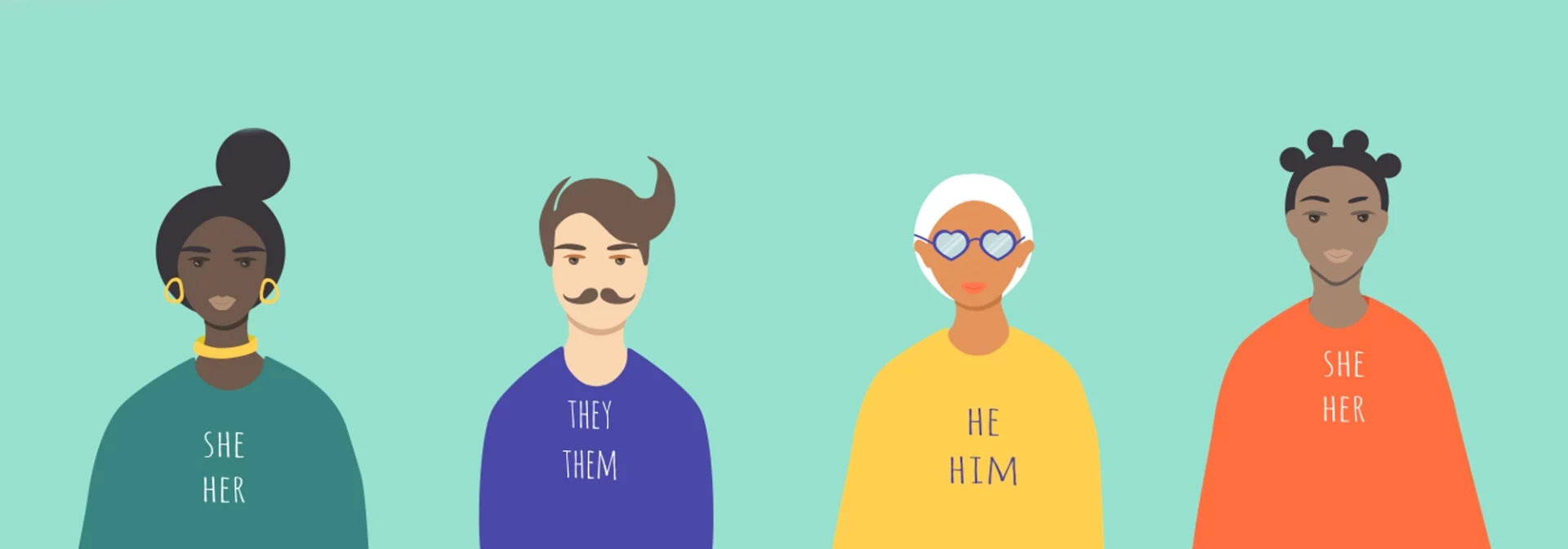What are pronouns and why do they matter? We talk about pronouns, gender-inclusive language, and how to be more inclusive.
Author Jen Bell | Reviewed by Mason Dunn
You may or may not have seen people adding their personal pronouns to their name tags, email signature, bylines, and more. Personal pronouns have become much more than just another way to refer to people, but a way to affirm one’s gender identity.
So where do you start? And, how do you use these pronouns respectfully and correctly?
What Are Pronouns?
Pronouns are the words we use to refer to another person, such as he, she, or they. Some people use specific pronouns, any pronouns, or none at all. Some people prefer that their name is used instead of a pronoun.
If you’re not sure about someone’s pronouns, ask them! It may sound weird or too overt to ask “What are your pronouns?” so instead say, “How should I refer to you?” or “How would you like me to refer to you?” This way, the person can decide if they want to tell you their pronouns or not.
Why Pronouns Are Important
Pronouns are an important part of many people’s gender identity. If someone uses the wrong pronoun to refer to someone else, whether accidentally or intentionally, they are misgendering that person — they are labeling them as a gender other than the one they identify with. Misgendering someone can cause them to feel stigmatized and self-conscious, and it can also put them in danger.
When you misgender someone who is transgender, you also run the risk of outing them to other people — letting other people know they are trans. Outing a trans person is not only disrespectful, it can put them in danger of harassment and discrimination.
Transgender people are the only ones who have the right to tell others they are trans, if they wish to. It’s never OK to tell people if someone is transgender or not, unless you have their explicit consent.
Examples of Common Pronouns & How to Use Them

Some people use different pronouns, or a combination of various pronouns. Some common pronouns include:
She/Her/Hers
- Example: She is hungry.
- Example: I’m meeting her after school.
- Example: The book is hers.
They/Them/Theirs
- Example: They are hungry.
- Example: I’m meeting them after school.
- Example: The book is theirs.
Xe/Xem/Xyrs
- Example: Xe is hungry.
- Example: I’m meeting xem after school.
- Example: The book is xyrs. (pronounces “zirs”)
Ze/Zem/Zirs
- Example: Zee is hungry.
- Example: I’m meeting zem after school.
- Example: The book is zirs.
He/Him/His
- Example: He is hungry.
- Example: I’m meeting him after school.
- Example: The book is his.
To learn more about new pronouns or “neopronouns” check out the website mypronouns.org.
The Singular “They” Pronouns
Did you know that “they” has been used as a singular pronoun in the English language for centuries? If you’re finding it difficult to use “they” as a singular pronoun, don’t worry, all it takes is practice!
Here’s an example of how to use they/them in a sentence:
Someone left their water bottle on the field.
Sharing Pronouns
It’s not possible to know someone’s pronouns just by looking at them. Sharing pronouns helps to create a welcoming space for people of all genders, and prevents people from making assumptions about anyone’s identity, or which pronouns they use.
When we tell people our pronouns, we let them know how we want to be seen and addressed — and we give them the opportunity to tell us how they identify.
You can make your pronouns visible by adding them to your nametag, email signature, social media bio, or by wearing pronoun jewelry or clothing.
Here are some helpful ways to invite people to share their pronouns:
- “Hey, I’m Jesse and my pronouns are they/them. It’s nice to meet you!”
- “My name is Sean. What’s your name and how would you like me to refer to you?

What if I Don’t Want to Share My Pronouns?
If your tween or teen does not want to share their pronouns, that’s okay! Not everyone feels comfortable or ready to share their pronouns. They should not feel pressured to share their pronouns. It should be presented as a choice for those who want to and feel comfortable with sharing their gender identity.
If they are questioning their gender identity, anxious about others’ reactions or being outed, afraid of bullying, or unsure if they are ready to try a new pronoun, let them know it is okay to ask people to refer to them by their name.
What to Do if I Use The Wrong Pronoun By Mistake
Everyone makes mistakes, but it’s important to take responsibility for your actions. When someone takes the time to correct you about their pronouns, they are doing you a favor. They’re letting you know how they want to be addressed, and showing you they see you as someone who wants to get it right.
Say sorry or “thanks for correcting me” and move on. Immediately begin using the correct pronouns. Avoid asking the other person for forgiveness or making a scene about how guilty you feel. You don’t want to end up making the person you misgendered have to console you.
Here’s an example of what to do if you accidentally use the wrong pronoun:
“I want to introduce you to Tina, she’s our new Accountant.”
(Your coworker reminds you that Tina uses they/them pronouns)
“Sorry, I want you to meet Tina. They are our new Accountant.”
What Is Gendered Language?
When we use phrases like, “hey guys” or “ladies and gentlemen” to address a group, we’re using gendered language.
These phrases, albeit unintentional at times, send signals about who is and isn’t included. If we refer to someone whose pronouns we don’t know using words like, “girl, boy, man, woman,” we run the risk of misgendering them and potentially outing them as transgender.
Gender neutral language enables us to refer to nonbinary people and talk about people without specifying their gender. We can address a group in a way that makes everyone feel included. This is good for us all — no matter our gender.

Tips for Using Gender-Inclusive Language
Try making these swaps for more gender-inclusive language:
- Instead of saying, Sir/ Madam/ Ma’am/ Miss/ Ms./ Mrs./ Mr. say the person’s first name or Mx (pronounced “Mix”)
- Instead of saying, The girl over there say That person over there with the red jacket.
- Instead of saying, ladies and gentlemen, guys, girls, boys, brothers and sisters say friends, folks, all, y’all, everyone, team, people, students, crew, peeps, pals.
- Instead of saying, boyfriend, girlfriend, wife, husband say partner, spouse, paramour, love, date, significant other, theyfriend.
- Instead of saying, mom, dad, mother, father, sister, brother, son, daughter say parent, child, sibling, youth, kid, grandparent, cousin, relative, caregiver.
